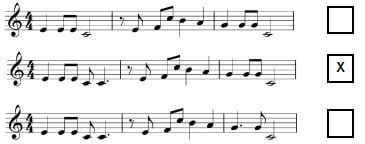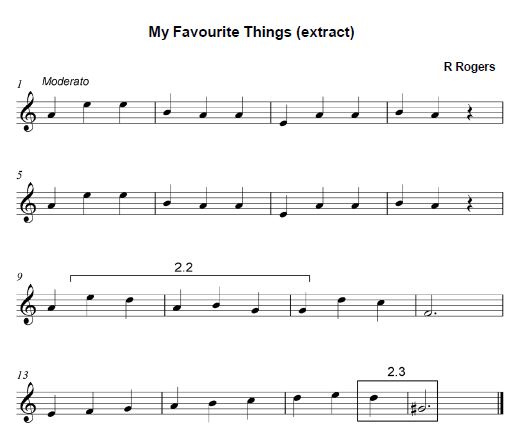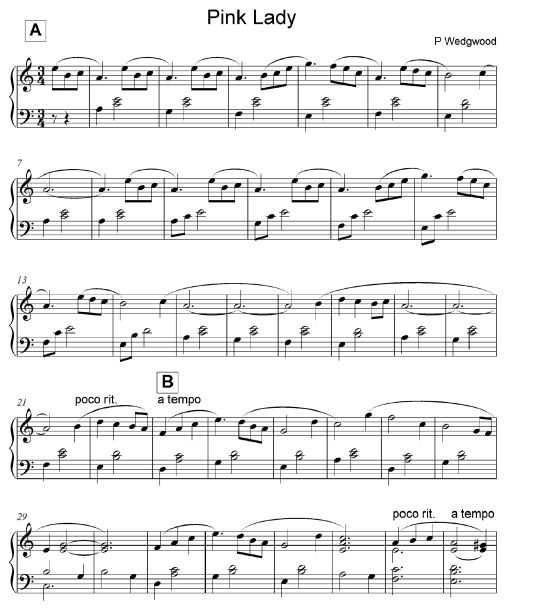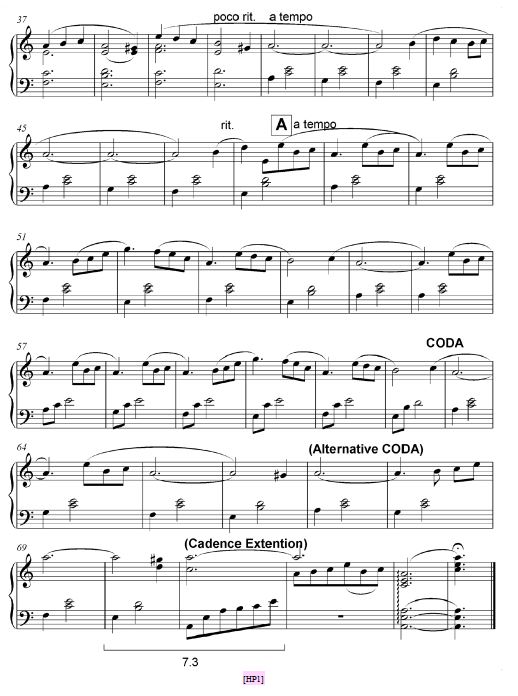MUSIC PAPER 2 GRADE 12 MEMORANDUM - NSC PAST PAPERS AND MEMOS NOVEMBER 2016
Share via Whatsapp Join our WhatsApp Group Join our Telegram GroupMUSIC
PAPER 2
GRADE 12
NSC PAST PAPERS AND MEMOS
NOVEMBER 2016
INSTRUCTIONS AND INFORMATION
- This question paper consists of THREE sections:
SECTION A: Aural (10)
SECTION B: Recognition (12)
SECTION C: Form (8) - QUESTION 1, QUESTION 2, QUESTION 3 and QUESTION 7 are compulsory.
- Answer QUESTION 4 (Western Art Music (WAM)) OR QUESTION 5 (JAZZ) OR QUESTION 6 (Indigenous African Music (IAM)).
- Write ALL your answers on this question paper. Use a pencil for music notation and blue or black ink for the other answers.
- This examination will be written while candidates are listening to a CD.
- The music teacher of the centre must conduct the examination in the presence of the invigilator.
- The last page of this question paper is manuscript paper intended for rough work. The candidate MAY NOT remove this page.
- Candidates may NOT have access to any musical instrument for the duration of this examination.
- Candidates must take note of the mark allocation at each question to provide enough information in their answers.
- Write neatly and legibly.
INSTRUCTIONS TO THE PERSON OPERATING THE SOUND EQUIPMENT
|
SUMMARY OF MARKS
SECTION A: AURAL | TOTAL |
QUESTION 1 (COMPULSORY) | 4 |
QUESTION 2 (COMPULSORY) | 6 |
SUBTOTAL | 10 |
SECTION B: RECOGNITION | TOTAL |
QUESTION 3 (COMPULSORY) | 4 |
QUESTION 4 (WAM) OR | 8 |
QUESTION 5 (JAZZ) OR | 8 |
QUESTION 6 (IAM) | 8 |
SUBTOTAL | 12 |
SECTION C: FORM | TOTAL |
QUESTION 7 (COMPULSORY) | 8 |
SUBTOTAL | 8 |
GRAND TOTAL | 30 |
Note to marker: Candidates must be credited for any correct answers not given in the memorandum. |
MEMORANDUM
SECTION A: AURAL
QUESTION 1
Play Track 1 TWICE in succession. |
1.1 Listen to the melodic and rhythmic phrase. Notate the rhythm of the missing notes in bars 3–4 below. 
Play Track 1 TWICE again. Pause for 30 seconds before the repetition. |
 (3)
(3)
½ mark per note as indicated = 3 marks |
Play Track 2 THREE times in succession. |
1.2 Which ONE of the extracts below corresponds with the melody that you hear? Make a cross (X) in the appropriate block.
The extract starts with a two-bar click track.  (1)
(1)
Correct answer = 1 mark |
[4]
QUESTION 2
Play Track 3 ONCE to provide a general overview. |
Listen to the extract from My Favourite Things. Answer the questions that follow.
Play Track 4 TWICE in succession. |
2.1 Identify the difference(s) in articulation between bars 1–8 and bars 9–16.
Answer:
- Bars 1–8 two-note slurs (beat 1 and 2), staccato on beat 3
- Bars 9–16 legato (smoothly-connected notes) (1)
One mark for difference between phrases = 1 mark ½ mark for one correct articulation |
Play Track 5 FOUR times. |
2.2 The notation of bars 9 and 10 has been omitted at 2.2 on the score. Fill in the missing pitches that correspond with the melody that you hear. (The track starts in bar 5.)  (3)
(3)
½ mark for each correct pitch x 6 = 3 marks |
Play Track 6 TWICE. |
2.3 Which interval is formed between the two notes in the block at 2.3? (The track starts in bar 13.)  (1)
(1)
Diminished 5th (or Augmented 4th or Tritone) = 1 mark |
2.4 Name the cadence with which the extract ends.
Answer:
Imperfect or Half (cadence) (1)
1 mark |
Play Track 7 for a final overview. |
TOTAL SECTION A: 10
SECTION B: RECOGNITION OF MUSIC CONCEPTS
QUESTION 3: GENERAL LISTENING (COMPULSORY)
3.1 You will hear TWO different performances of the same piece: Track 8 and Track 9. Listen to these extracts and answer the questions that follow.
Play Track 8 and 9 TWICE in succession. |
Compare these two extracts in terms of the following:
Answer: (3)
ELEMENT | COMPARISON | |
Track 8 | Track 9 | |
Use of rhythm |
½ |
½ |
Tempo | Faster ½ | Moderate ½ |
Instrumentation | Mainly strings (with woodwinds/ clarinets/flutes and triangle) or Orchestral ½ | Big Band (Brass and Saxophones) ½ |
Correct answers: one per element = 3 marks |
Play Track 10 and Track 11 ONCE each. |
3.2 Indicate only ONE feature that you hear in EACH of these tracks. Make a cross (X) in the appropriate block.
Answer:
FEATURE | Track 10 | Track 11 |
Solo improvisation | ||
Walking bass | X | |
Monophonic | ||
Giocoso | X | |
Triple metre |
(2)
2 correct answers = 2 marks |
Play Track 12 TWICE. |
3.3 Name any THREE features that indicate that this piece is typically African.
Answer:
- Call and response
- Polyrhythms
- Repetition
- African drumming
- Pentatonic scale used
- Syncopation
- Cyclic structure
- African language (3)
Any 3 correct answers = 3 marks |
(8 ÷ 2) [4]
Answer QUESTION 4 (WAM) OR QUESTION 5 (JAZZ) OR QUESTION 6 (IAM).
QUESTION 4: WAM
4.1 Listen to the extracts from The Magic Flute by Mozart and answer the questions that follow.
Play Track 13 TWICE. |
4.1.1 With which subgenre in opera music do you associate this extract?
Answer:
Aria or Singspiel (1)
1 mark |
4.1.2 Name the character who sings in this extract.
Answer:
Papageno or Bird catcher (1)
1 mark |
4.1.3 Where in the opera is this extract sung?
Answer:
- Act 2 (Scene 5)
- Towards the end of the opera when Papageno is confined in Sarastro’s temple (1)
Any correct answer = 1 mark |
4.1.4 Name the idiophone that you hear in this extract.
Answer:
- Celesta
- Glockenspiel or Metallophone
- Glass harmonica
- Bell
- Music box (1)
Any correct answer = 1 mark |
Play Track 14 ONCE. |
4.1.5 Which Italian term best describes the tempo changes at the end of this extract?
Answer:
- Ritardando or Rit.
- Rallentando or Rall.
- Ritenuto or Rit. (1)
Any correct answer = 1 mark |
Play Track 15 TWICE. |
4.1.6 The time signature changes in this extract. Identify the new (second) time signature. Make a cross (X) in the appropriate block.
Answer:
6
8 (1)
1 mark |
Play Track 16 ONCE. |
4.1.7 Listen to a section of the overture to The Magic Flute. How does this extract succeed in setting the mood of the opera?
Answer:
- 3 chords
- links with 3 knocks, 3 doors, 3 pillars
- Symbolic number (Masonic influence)
- Slow majestic, grand, misterious chords
- links with formal serious moral issues (light and dark, good and evil)
- Polyphonic section
- link to complexity of the opera
- Staccatos, syncopation, quick tempo
- links to Queen of the Night aria
- lighter moments and playful nature of some characters (2)
Any 2 correct facts = 2 marks |
Play Track 17 ONCE. |
4.1.8 Describe the texture of this extract.
Answer:
- Starts homophonic/chordal followed by polyphonic/contrapuntal texture
- Homophonic first section/Polyphonic second section (1)
Any correct answer = 1 mark |
4.2 Listen to the extracts below from Beethoven's Symphony No. 6 and answer the questions that follow.
Play Track 18 ONCE. |
4.2.1 What is the function of this extract in Beethoven's Symphony No. 6?
Answer:
- The linking passage between the fourth (The Storm) and fifth (Shepherd’s Song) movements
- Uninterrupted flow of musical ideas linking one programmatic scene to the next (1)
Any 1 correct fact = 1 mark |
Play Track 19 TWICE. |
4.2.2 Listen to the higher-pitched instruments in this extract. Choose the correct description below that corresponds with the music. Make a cross (X) in the appropriate block.
Answer: (1)
A legato melody, followed by a non legato passage on the solo clarinet | |
A legato melody, followed by a legato passage on the solo flute | |
A legato melody, followed by a non legato passage on the solo flute | X |
A legato melody, followed by a legato passage on the solo clarinet |
Play Track 20 TWICE. |
4.2.3 Which TWO of the following Italian terms apply to the music you hear? Make a cross (X) in TWO appropriate blocks.
Answer: (2)
Crescendo | X |
Decrescendo | |
Pesante | |
Grazioso | X |
Scherzando |
2 correct answers = 2 marks |
4.3 Listen to the following extract by Mendelssohn. Answer the question that follows.
Play Track 21 TWICE. |
Indicate THREE items in the list below that are CORRECT in relation to the music that you hear. Make a cross (X) in THREE appropriate blocks.
Answer: (3)
Inverted pedal point | X |
Melody in flute part | |
Ostinato | |
Minor tonality | X |
Allegro | X |
Adagio |
3 correct answers = 3 marks |
(16 ÷ 2) [8]
TOTAL SECTION B: 12
OR
QUESTION 5: JAZZ
5.1 Listen to the extracts below by The Brotherhood of Breath and answer the questions that follow.
Play Track 22 ONCE. |
5.1.1 Identify the jazz category. Make a cross (X) in the appropriate block.
Answer:
Jazz in exile (1)
1 mark |
Play Track 23 ONCE. |
5.1.2 Describe the mood of this extract by referring to the tonality.
Answer:
- Major key
- Upbeat/jolly mood (1)
Major = ½ mark; upbeat/jolly = ½ mark |
5.1.3 Name ONE membranophone that you hear in the introduction.
Answer:
- Conga drums or Djembe
- Any drums, part of the drum kit that is a membranophone (1)
Any correct answer = 1 mark |
Play Track 24 TWICE. |
5.1.4 Between which instruments/instrumental sections does the call and response feature in this extract?
Answer:
Between brass/horn section and piano (1)
1 mark |
5.1.5 Describe TWO characteristics of this piano-playing style.
Answer:
- Lots of repeated notes typical of South African music
- Percussive tone quality
- Chordal comping
- Fragmented melodic line (2)
Any 2 correct answers = 2 marks |
5.1.6 Name another band that is linked to this style of jazz.
Answer:
- The Blue Notes
- The Jazz Epistles
- Union of (South) Africa (1)
Any of the above mentioned bands or any other suitable band =1 mark |
5.2 Listen to Spirits Rejoice and answer the questions that follow.
Play Track 25 TWICE. |
5.2.1 Identify the jazz style.
Answer:
- Jazz at home/South African Jazz
- Jazz Fusion
- Afro Jazz
- Jazz Funk (1)
Any correct answer = 1 mark |
5.2.2 Give reasons, related to the music, to motivate your answer to QUESTION 5.2.1.
Answer:
- Mixing funk with rhythm and blues elements
- Wind/brass section playing arranged lines (Big Band)
- Pop/rock influences in drum kit and percussion
- Prominent electric bass line (2)
Any 2 correct answers = 2 marks |
5.2.3 Name ONE other artist/band that you associate with this style of music.
Answer:
- Sakhile
- Sipho Gumede
- Bheki Mseleku
- Union of (South) Africa
- Blood, Sweat & Tears (International)
- Zim Nqawana (1)
Any of the above-mentioned artists/bands or any other suitable artist/band = 1 mark |
Play Track 26 ONCE. |
5.2.4 Which solo instrument do you hear in this extract?
Answer:
Trumpet/Cornet/Flugel horn (1)
1 mark |
5.3 You will hear TWO music extracts: Track 27 and Track 28. Listen to these extracts and answer the question below.
Play Track 27 and Track 28 ONCE each. |
Identify the music style of EACH extract and give ONE reason for EACH answer.
Answer:
Track | Style | Reason |
27 | Mbaqanga |
|
28 | Marabi |
|
1 mark for each correct style = 2 marks 1 mark for each correct reason = 2 marks |
OR
(4) (16 ÷ 2) [8]
TOTAL SECTION B: 12
QUESTION 6: IAM
6.1 You will hear TWO tracks: Track 29 and Track 30. Listen to these tracks and answer the question below.
Play Track 29 and Track 30 ONCE each. |
Identify the music style of EACH extract and give ONE reason for EACH answer.
Answer: (4)
Track | Style | Reason |
29 | Maskandi |
|
30 | Mbaqanga |
|
1 mark for each correct style = 2 marks 1 mark for each correct reason = 2 marks |
6.2 You will hear TWO tracks: Track 31 and Track 32. Listen to these tracks and answer the question that follows.
Play Track 31 and Track 32 ONCE each. |
6.2.1 With which of the following descriptions do you associate the instrumental ensembles that you hear? Make TWO crosses (X) in the appropriate blocks for EACH track.
Answer: (4)
DESCRIPTION | Track 31 | Track 32 |
Maskandi band | ||
Marimba band | X | |
Sudden dynamic changes | X | |
Drum ensemble | X | |
Aerophones | ||
A cappella group | ||
Membranophones | X |
4 correct answers = 4 marks |
Play Track 33 and Track 34 ONCE each. |
6.2.2 Indicate the similarities between the extracts. Refer to the rhythm and tempo.
Answer:
- Repetition of rhythmic patterns
- Polyrhythms
- Syncopation
- Same moderate tempo (2)
Any 2 correct answers = 2 marks |
Play Track 35 ONCE. |
6.2.3 Identify the vocal techniques that you hear in this extract.
Answer:
- Crepitation
- Ululation
- Vocal glissando (2)
1 mark each = 2 marks |
6.3 Listen to the extract and answer the questions that follow.
Play Track 36 TWICE. |
6.3.1 Identify the style of South African music.
Answer:
Malombo (1)
1 mark |
6.3.2 Give TWO reasons, related to the music, to motivate your answer to QUESTION 6.3.1.
Answer:
- Fuses musical traditions of the Bapedi and VhaVenda with jazz
- Typical instruments (flute, African drums, electric guitar)
- African rhythms provided by percussion instruments
- Blues influence in melodic line of flute
- Jazz-based guitar-playing
- Loose improvised melodic and rhythmic phrases (2)
Any 2 correct answers = 2 marks |
6.3.3 With which group/artist do you associate this style of music?
Answer:
- Phillip Tabane
- Phillip Tabane and Malombo
- Malombo Jazz Men
- Malombo Jazz Makers
- Julian Bahula
- Abby Cindi (1)
Any correct answer = 1 mark |
(16 ÷ 2) [8]
TOTAL SECTION B: 12
SECTION C: FORM
QUESTION 7
Read and study the questions for THREE minutes.
Play Track 37 ONCE to provide an overview. |
Listen to Pink Lady while you follow the score.
Play Track 37 ONCE again. |
7.1 What is the form of this piece?
Answer:
- Ternary (with coda)
- ABA (with coda)
- Rounded binary (1)
Any correct answer = 1 mark |
7.2 Motivate your answer to QUESTION 7.1 by giving a schematic layout of the form of this piece. Use the table below.
Answer: (4)
SECTION | BAR NUMBERS |
A ½ | 02b – 222 ½ (1–22) |
B ½ | 223/231 – 482a ½ (23–48) |
A ½ | 482b – 622 ½ (48–62) (623 – 742a ½ (63–74)) 482b – 742a ½ (48–74) (1 mark if no coda) |
Note to the marker: the coda can also start in bar 67. |
½ mark for each correct section = 2 marks |
Play Track 38 TWICE. |
7.3 Follow the music score from bar 623 to the end. Name the cadence in bars 70–71.
Answer:
Perfect cadence (1)
1 mark |
Play Track 39 TWICE. |
7.4 Follow the music score from bar 02 to bar 142. Notate TWO prominent rhythmic motifs that occur in this extract. 
Any 2 motifs = 2 marks |
[8]
Play Track 40 for a final overview. |
TOTAL SECTION C: 8
GRAND TOTAL: 30


